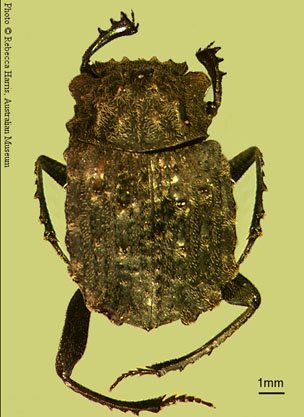![]()
![]()
![]()
Genus Amphistomus
 Species found in eastern NSW: A. macphersonensis, A. speculifer, A. primonactus, A. trispiculatus.
Species found in eastern NSW: A. macphersonensis, A. speculifer, A. primonactus, A. trispiculatus.
Other species: A. squalidus, A. inermis, A. pygmaeus, A. complanatus, A. tuberculatus, A. calcaratus, A. accidatus, A. palpebratus, A. pectoralis, A. montanus, A. opacus, A. storeyi, A. cunninghamensis (Qld)
A. tuberosus (NT)
Distribution
The entire east coast of Australia from southern New South Wales to Cape York, the Northern Territory near Darwin, the Torres Strait Islands and New Guinea.
Description
Small to medium (4.0-10mm), oblong, convex or trapezoidal in cross-section, sides often nearly vertical, dorsal surfaces often flat. Colour reddish-brown to black, sometimes with slightly paler markings on elytra. Dorsal surfaces covered with curved setae, with tubercles and keels.
Six clypeal teeth, of which the middle two are a little longer; anterior part of underside of pronotum with a deep excavation bounded by a strong keel.
Elytra: elytra with 10 striae, 7 on disc, 3 on pseudepipleura. Striae very shallow, intervals not convex. Tubercles present on odd-numbered intervals only. Lateral edges of elytra with series of teeth, tubercles or undulations.
Hind wings: Either fully developed, reduced or absent.
Legs: Outer edge of fore tibiae with 3 large teeth. Middle coxae short, parallel and widely separated. Middle tibiae with 2 transverse keels on outer face. Spurs extremely short. Claws very small, simple.
Abdomen: Sternites foreshortened, crowded together in middle. Pygidium flat, to moderately convex, finely bordered, with a maximum of 7 tubercles on disc.
Sexual dimorphism
Male with slightly smaller clypeal teeth, pronotal sculpturing more pronounced, shorter abdominal sternites and longer pygidium, hind legs with one or more teeth or spines on the hind edge of the femur and sometimes one on the trochanter, the hind tibiae often strongly bowed to accommodate the femoral spine.
Similar Genera
Aulocopris, the only other genus with tuberculate elytra.
Obvious differences:Aulocopris larger, with two small clypeal teeth.
Demarziella, with rugose, uneven elytra covered with bristles and setae.
Obvious differences: Demarziella smaller, with two small clypeal teeth.
Ecology
Coprophagous, both flightless and winged species, in forests of various types, mostly humid.
References
Cassis, G. & Weir, T.A. (1992) Scarabaeinae. pp 106-173. In: Houston, W.W.K. (ed.) Zoological Catalogue of Australia. Coleoptera: Scarabaeoidea. Canberra: AGPS Vol. 9.
Matthews, E.G. (1974) A revision of the Scarabaeine dung beetles of Australia. II. Tribe Scarabaeini. Aust. J. Zool. Suppl. Ser. 24: 1-211.
